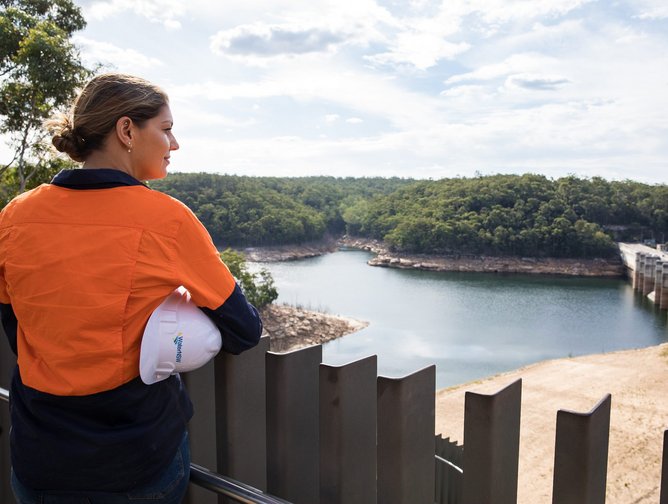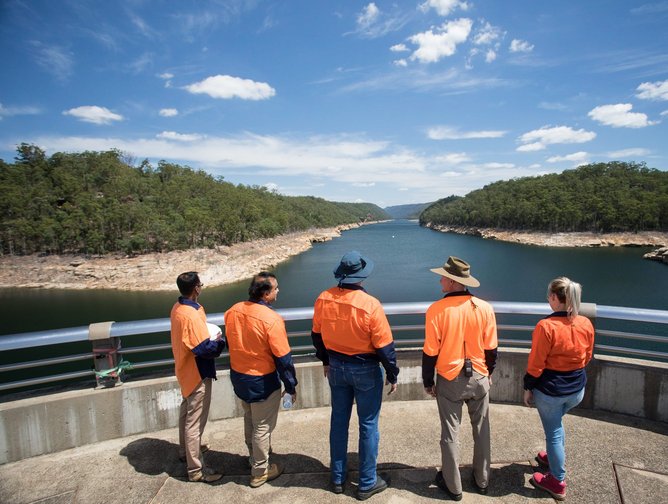WaterNSW Harness Cloud and IoT to Better Serve Customers
Founded in 2015, WaterNSW is a state-owned corporation, established under the WaterNSW Act 2014. Operating the state rivers and water supply systems, WaterNSW supplies two-thirds of the water used in NSW to regional towns, irrigators, the environment, Sydney Water Corporation and local water utilities.
Working for the company since its founding, Adrian Langdon, Executive Manager System Operations reflects on his time at the company and how it has evolved: “We still supply water, this is something that hasn’t changed, but the level of customer engagement and the amount of information that we are providing to customers now, compared to before, has grown. We have also shifted from traditional paper interactions with customers to digital interactions, and it is this journey in particular that we are focusing on now, taking previously office-based work online. In the last eight months, a lot of our meetings and similar operations with people around the state are being conducted through the digital environment (Microsoft Teams, Zoom). This is an area where we are seeing some big changes since I joined the company.”
Combined, Langdon and Ian Robinson, CIO have more than 30 years of experience in water and utility services. In particular, Robinson has worked in the IT space in the utility sector, joining WaterNSW in 2018 to drive the company’s business transformation agenda.
“We've established a transformation agenda based on a vision of the future that describes what the workforce of the future will be doing that is different to today,” says Robinson.
“To enable that, we've built a roadmap of initiatives to get us to that point, which involves transitioning customers from paper-based transactions to digital channels, enabling our system operations team to have data at their fingertips rather than having to extract data from a myriad of different systems; and enabling our field staff to replace mundane manual tasks with automated data collection solutions using IoT and on-site mobile solutions. These things combined will change the way we work; it will allow our people to work on higher-value activities and enable them to focus on the needs of our customers.
“The transformation will allow us to focus on higher-value activities, such as predicting the water needs for our customers, enabling customers to see those predictions and allowing customers to make better decisions for the future based on the availability and quality of water we can supply. And those processes will enable WaterNSW to work with our ecosystem in a way that establishes us as a source of information for better decisions by other parties in the water market.”
Harnessing Cloud and IoT at WaterNSW
As part of the business transformation agenda at WaterNSW, the company is developing an IoT gateway built on a platform-as-a-service (PaaS) cloud solution. “Field equipment such as measurement sensors are connected to a telecommunications network to provide data in real-time back to the data lake where it is provided for a myriad of consumers through a data catalogue. All of that happens in one platform and the IoT gateway effectively provides the interface to the public carrier network or the satellite system that provides a communications network from the field to the gateway to connect that data for downstream processing.”
“The consolidation of data through consolidated gateways to a single source of truth data lake stops the need for people to intervene in the process and therefore interrupt the integrity of the data. Data governance then becomes oversight of data flows and associated processes to continually adapt the processes to changing requirements or error types.
“Adrian often talks about the need to make sure that all of our stakeholders have a standardised definition of what that data is so that their interpretation of the data is the same as ours. Often in the past, data has been misinterpreted because of the lack of an agreed business glossary, which means people can understand it to mean something different to how we intend it to be. The data lake enables us to put very clear tags on that data and make sure that the definition is included in a business glossary and allows people access to that in a standardised way.”
Implementing new technologies and processes do not come without challenges; for WaterNSW the primary challenge was legacy environments. “We have lots of different disparate data sources and trying to bring all those together using lots of legacy and proprietary data protocols is a significant challenge. We needed to accommodate each of those legacy proprietary technologies so that we could translate those into a standardised form. The next challenge was then to capture the business rules that have been traditionally in people's heads or those various disparate systems and codify in automated data processes. That's required us to reimagine our data flow and the rules and constraints we put around that data to make sure data is handled in a consistent way. In doing that, we've delivered a comprehensive capability across all of our data that enables consumers to trust the data and to readily fix errors that stay fixed when they are identified.”
Better Serving Customers
With water being one of the most critical elements, whether it be from an agricultural point of view or from a town’s water supply, Langdon explains the relationship WaterNSW has with its customers, “it is a very important relationship because, really, water transfers in a continual motion, therefore that relationship has to be very strong and we need to be able to work very closely together with customers to optimise the use of water and to synchronise the release of water to match demand. Water, being a limited resource, requires us to work with our customers to ensure that we manage it in the most efficient way possible, and we have to do that in a partnership.”
By developing the IoT gateway, WaterNSW can allow its customers to find information at their fingertips. “This is actually giving us the opportunity to get accurate timely data through to the customer, who is making significant financial business decisions in some cases, especially in the agricultural field; having information in a timely manner is essential for them to make good business decisions. Our consolidated data lake fed by emerging IoT sensors is giving us good quality data which our customers are able to move forward with and I think that’s the partnership that we are trying to continuously form with our customers in order to meet their needs. All of this data is visualised in an industry-leading online platform called “WaterInsights”.
Langdon reiterated the importance of putting customers at the heart of all decision-making, including technological change. He pointed to WaterInsights as a prime example of listening to your customers and then delivering a product to not only meet but exceed, their expectations:
“Our first step towards establishing this has been the introduction of WaterInsights. The WaterInsights product was born from the desire of our customers to see all information, pertinent to them, in one location. WaterInsights has delivered this in a user-centric format that puts the information that our customers told us was important at their fingertips. Excitingly, our next release, which is due mid-2022 will see us being able to push out key operational information, such as supplementary flows and outages, to our customers without them having to search for it.
While giving our customers a tool to enable better water management decisions, we have also created the ultimate transparent web tool that provides meaningful and up to date information to support our customers, stakeholders, and communities in better understanding water management in NSW.”
The product, built using agile methodologies by ADASA, reflects the way customers want to see our data. We know this through customer testing we have done, and great care was taken in listening to customer feedback and building that into a user interface that presents data in an easy-to-understand way. In working with our government policymakers, the portal also provides water access rules in plain English for customers to understand the terminology and the reason water allocations are set and how access to the water is managed.
“But our customers don’t just require information. They also need us to act on their behalf. If they have a need for water and they want to gain a licence to access that water or order water to enable us to deliver that water to them, we've built digital channels to enable them to interact with us through a customer portal and be able to look at their account and understand how much water has been used against their total allocation for the year and as changes occur. For example, Adrian has supplementary notifications that he can advise and communicate to customers, allowing them to act on that information, bid for the water, trade water, and maximise the value of their allocation.”
WaterNSW’s 360 Degree Customer View
When asked about WaterNSW’s 360-degree view of its customers, Robinson describes it as a customer-centric view. “A customer can have a whole set of licences, each of these licences can have multiple customers associated with it, then the customer will have orders, accounts, bills and transactions that occur. The 360-degree view allows the customer service operator and the customer themselves to see all of those interactions in one place in a context for their personal customer profile. Having implemented a CRM for the first time, service operators can then, in context, understand what the customer's position is, where they are sitting with their transactions, what problems they've had in the past, and what payment schedules they've had. This allows us to have a really rich experience in interacting with the customer that allows us to prove to the customer that we know and understand them.
“Our CRM solution is not only a record of customer interactions and case management for enquiries, it is also a business process automation solution using Pega software. From a CRM perspective, it provides a web-based customer portal that captures customers’ views from social media, voice contact, chatbots or email contact. All of those different channels all funnel into one single view for the internal customer service officer. It also enables customers to take into their own hands, the process of applying for and transacting with WaterNSW, so a lot of care has been taken in the CX/UX experience for a customer trying to initiate a transaction, such that, we put it into the way a customer thinks. Having entered the data, the information is processed through business rules to give the customer an automated, if possible, outcome. Ultimately, it’s about enabling WaterNSW to work in the way the customer needs, while also allowing for a reduction in the mundane task of entering data and, most importantly, allows us to focus on improving customer service.
Pega, at its roots, is a business process management engine that allows us to automate steps where business rules are met which results in the need for human intervention only when rules require it or where complex interactions are required. This is what lifts the focus of our staff from low to high value work. We can move from administration to advisory, from long cycle times pushing paper to quick cycle times with customers that really understand the nature of their assessment and the reason for the outcome of the assessment.”



